Applique Circle Prep
When we last met, I mentioned my love for circles in quilts — pieced circles (wedges…), whole circles — I’m an equal opportunity circle lover. Except when it comes to execution of quilts with lots of whole circles. I’d get all jazzed up about starting a circle quilt, start with my favorite method of prepping circles and then get entirely bored and bogged down in the prep work. ::sniffle:: No circle quilts until you prep your circles, young lady!
Mind you, I’d had one of those quilt-life-altering experiences when I took a class from Karen Kay Buckley. You know, those moments when a great teacher shows you something and you feel like they’ve just unlocked the secrets of the universe. That’s what she did one fine spring day in northern Michigan. She showed us how to make perfect circles with heat resistant templates (or washers, at the time), starch and a running stitch. As in, trace your circle template, stitch an even running stitch within the 1/4″ seam allowance (leaving a nice tail), put the template back in the circle, pull up the stitches, paint the seam allowance with starch and dry it with a medium hot iron. Carefully, loosen a few stitches so you can remove the template, gather the circle back up and give it one last good press. Voila! Perfect circles, no pointy, uneven or flat bits.
Now, if you want to see a demo of this, Karen Kay Buckley has a new applique DVD out. I am certain it is wonderful because she is a fabulous teacher! You can also go see the lovely Janet’s post which includes another mind-blowing idea for small circles (i.e., don’t cut out your circle until you’ve done the running stitch!)! We are surrounded by genius!
Anyhoo, since the Karen Kay Buckley class, I’ve used this method to prep circles. But, gosh, a girl’s attention can start to wander when she has eighty-bazillion large-ish circles to prep. The running stitch on the larger circles just takes such a long time. Whine, whine, whine.
Knowing that, I — for some reason — volunteered to do a circle quilt recently. Well, what can I say, the fabrics were fun and the method was a stroke of genius by Mary Lou Hallenbeck. This method makes great use of the fabric because you cut out your circle from a square and then you applique a circle back onto the square after you’ve done a little magic trick to the square — make the hole in the square smaller by adding 1/4″ seams.
But there was still the problem of prepping the circles that would be appliqued to the squares…hmmm…. I do love a good round of Trouble-shoot This Quilt (the home game). What to do, what to do. I went to my bookshelves. Surely there was circle info and inspiration there.
Here’s something to consider, the six-minute circle as described by Dale Fleming in Pieced Curves So Simple:

You can find a tutorial for this at HGTV’s site or over at Dioramarama.
Nope, that wouldn’t work in this situation since I didn’t have a square upon which to applique the circle. I mean, I guess I could have tried and then wept in frustration because my seam allowances weren’t working out.
I also had Reynola Pakusich’s Circle Play book:
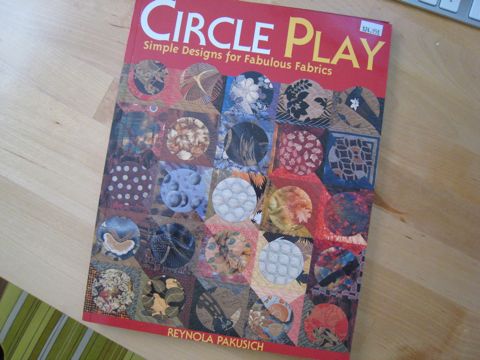
Say, what’s this? She cuts out circles from freezer paper, irons them to the wrong side of the circle fabric, cuts out adding seam allowance and then MACHINE STITCHES within the seam allowance. She then gathers the machine stitching and presses it around the freezer paper. That sounded promising.
So, I tried it. But I found that I was getting flat spots when I pulled up the stitching. I then tried NOT pulling up the stitching. EUREKA! The machine gathering stitch made these nice little cups anyway, so I could insert my heat resistant template into the middle, paint the seam allowance with starch, press with the iron and do a dance of joy.
I started out with a pile of circles and a pile of, well, holes:
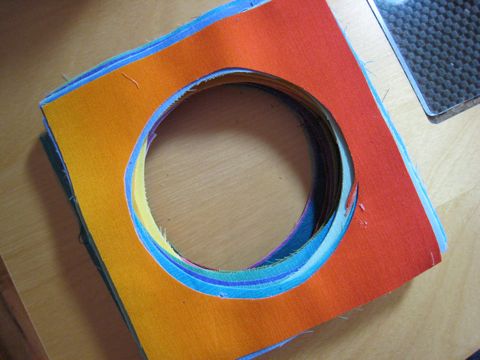
I machine stitched around all of the circles making these Gelato cups:

And then I added the circle template (cut from heat resistant template plastic):

And worked my way around, painting the seam allowance with starch, drying it with the iron, painting a little more seam allowance and so on. I really like using a small stencil brush for painting the starch on — the bristles are short and strong and really help to turn the seam allowance up over the template’s edge:

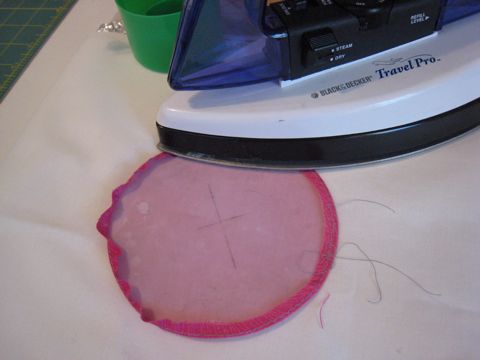

I can then easily slip the template plastic out of the pressed circle:

Keep going until you have a pile of prepped circles:
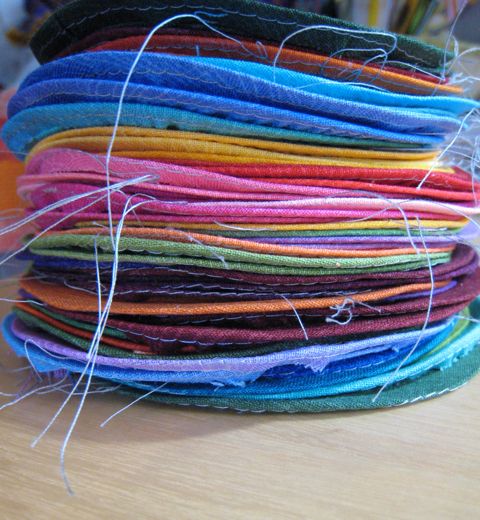
Meanwhile, your sewing alter ego is stitching 1/4 seam allowances in the holes:

Next, you’ll wanna clean the dried glue out of your Roxanne’s applique glue applicator:

Yes, it’s worth it to do this…
Then apply glue dots around the circle’s seam allowance (I found it is less messy to put the glue on the circle rather than on the hole…):

Then turn a hole square, if you will, onto the back of the circle and ease the hole around to make it fit onto the circle. This was tricky because I didn’t have much leeway given the method involved and the touchiness of the seam allowance. I decided to use this approach because the background/hole square was very unstable at this point. I figured glue basting would help me out. The seams in the background/hole square want to poke out, so it’s very important when glue basting to get the seams securely glued to the circle’s seam allowance.

I then let my squares dry for a while before taking them to the machine to applique:
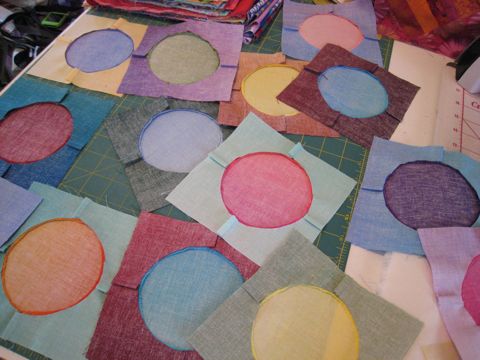
After they’ve dried for a little while, I use invisible thread and a variant of a blind hem stitch on the machine to applique the circles to the background:

After the applique is done, I like to give the squares a shot of starch and then press with a pressing cloth. I may have to trim some of my corners to straighten the blocks slightly.
The prep with this method is a little tricky, like I said, because you’ve cut the circles from the same background squares. The finished circle size MUST cover the hole in the background. I found it helped to take a generous 1/4″ seam allowance in the background squares.
I think this method works best for larger circles, the ones above are about 4 1/2″, the ones below are 3 1/2″. I’ll continue to do a hand running stitch for smaller circles as I think it will give the best result for the smaller ones.
But, really, this method of prepping circles can be used when you don’t have the added trickiness of having cut your circles from your background squares. I mentioned Anne Perry’s Jelly Beans quilt yesterday and I have begun prepping circles to make a version:


This is going to work wonders for this quilt!

I now have a tidy pile of circles to hand applique to full squares of background. Can almost get one done while sitting in the kid camp pick-up queue.
I don’t know, this has just been a very satisfying session of trouble shooting this week and I feel like I’ve broken through my barrier (laziness…) to more circle quilts. I hope this helps someone else too. If you’d like something clarified or have questions, just leave a comment! Happy circling!



Sheila A. Litsch said
Thanks for your help. I’m not happy with how my circles turn out using needle turn) although I must say that they’re not bad). Maybe I just need more practice doing it that way. But it is always nice to have options
Michelle said
Hi there..
My name is Michelle and I’m a mother of two.
I’m knew to the ‘Blogging world’ and came across your blog as I was looking at Lynda’s stunning quilt..
I love your circles and they way you applied a slighty different method in using templet… My passion is making quilts and I also do a little ‘flok art’… I am always looking for great ideas and would like to follow your blog, if that’s ok with you….Take care….Cheers 🙂
Elaine said
I have never seen this done before and it looks great! and it is a good way of getting rid of stash material. Thank you ever so much.
susan said
thank you for this. your circles are so stinkin perfect!
there is another method where you make a circle template from the plastic then have a circle of tinfoil too. lay the foil down, then the circle of fabric face down, then your plastic template. then you iron the edges up and around and the heat from the foil makes it conform nicely
A-M Finlay said
Thanks for the scoop on Karisma Pencils – I was “hooked” on yet another gadget until I saw your site…I too love my regular lead pencil and very fine gel pens (JoAnns) in all colors when doing my applique work.
Lynette said
Thank you for sharing! Why, oh why, had I never thought of slipping the heat-resistant template in to iron around? 🙂
Loralee said
I have been admiring a quilt that Garnet Hill carries every once in a wile in their catalog called the Johanna Quilt. See link…..
http://www.garnethill.com/johanna-quilt-and-sham/bedding-home/quilts-coverlets-shams/view-all-coverlets-quilts-shams/117769
It’s a little out of my budget and no longer available….So, I have been trying to figure out how they appliqued those perfect little circles all over that quilt… It looks like the method they used is like the one Mrs. Schmenkman is using toward the bottom of her step by step instructions (appliquing the circles onto the fabric rather than fitting them in the squares with the holes cut out). Is there anyone with some experience with this type of appliquing that can help me figure out what method I should use to duplicate my “inspiration” quilt from Garnet Hill?
Thank you!
Loralee
Sandra in the UK said
How fantastic is this. I hate doing circles, but your tutorial has given me courage to try again. Thanks!